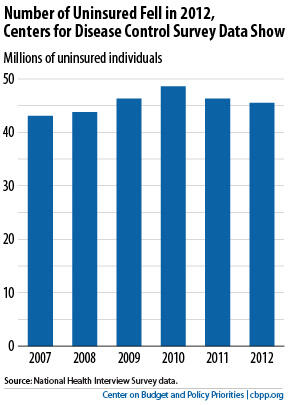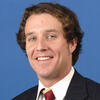off the charts
POLICY INSIGHT
BEYOND THE NUMBERS
BEYOND THE NUMBERS
The Census Bureau’s estimates of the number of Americans with and without health insurance in 2012 don’t come out until tomorrow, but other data and historical trends provide clues to what they will show, our report explains. Here are four things to look for.
- The number of uninsured fell but remains above pre-recession levels. The number of Americans without health coverage fell by 800,000 in 2012 to 45.5 million (see graph), according to early estimates from the National Health Interview Survey (NHIS), which the Centers for Disease Control and Prevention (CDC) released in June. The NHIS is a nationally representative sample that tends to track well with the more widely known Census Bureau data from the Current Population Survey.
- An important health reform provision expanded coverage for young adults. The largest increase in coverage in 2012, according to the NHIS data, occurred among young adults, a group benefiting from a health reform provision that allows adult children up to age 26 to stay on their parents’ private insurance plans. In 2012, 57.2 percent of adults aged 19-25 had private coverage — a full percentage point more than in 2011 and 6.2 percentage points more than in 2010.
- Private coverage continues to erode for other non-elderly adults. Private insurance coverage rates for non-elderly adults overall remained stable for a third straight year in 2012, according to the NHIS data. But this masks the continued deterioration of private coverage among those not affected by health reform’s young-adult provision. Among people aged 26 through 64 — a group for whom health reform’s major coverage expansions won’t take effect until next year — the private coverage rate fell for the fifth straight year in 2012.
- Public programs continue to serve more people during the recession, particularly children. Medicaid and the Children’s Health Insurance Program (CHIP) are a growing source of coverage for children and adults, particularly during the recent recession and its aftermath. These gains partly reflect a health reform requirement that states maintain their eligibility rules and procedures for Medicaid and CHIP. The share of children under age 18 with publicly funded coverage rose by to 42.1 percent in 2012, according to the NHIS data. This growth pushed the overall percentage of children who were uninsured down to a historic low of 6.6 percent. The percentage of children who are uninsured has been cut in half since 1997, despite the continued erosion of private insurance coverage.
Image

The public coverage rate among adults also has risen steadily but — unlike among children — has not fully offset the decline in private coverage, so the percentage of non-elderly adults who lack coverage has continued to grow. But health reform’s Medicaid expansion should result in substantial progress in covering adults, just as earlier Medicaid and CHIP expansions have done for children.
Stay up to date
Receive the latest news and reports from the Center
